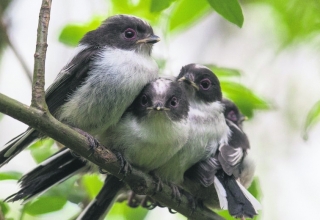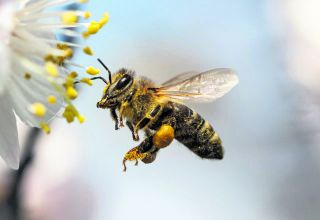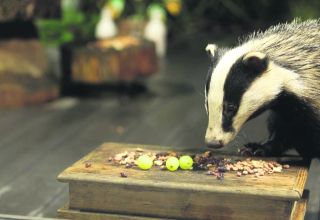
One of the finest sights at a garden feeding station in autumn and winter is a large group of long tailed tits feeding together. These sociable, attractive little birds will fly in their undulating flight to a peanut or seed holder one by one and soon there’ll be a flock of ten to 12, all feeding together.
With long tails, longer than their fluffy, dusky pink bodies and cute little black and white heads, gardeners who love to feed wild birds will be pleased to see so many because in severe winters their numbers can fall dramatically. Also, we don’t see them as much as other regular birds as they fly in and out again in search of another quick snack.
Gregarious and noisy, flocks of around 20 long tailed tits can be seen in hedgerows and bushes especially in winter, hardly ever descending to the ground. They are found across the UK except for the far north and west of Scotland. As well as woodland, farmland and hedgerows, these little birds are found in scrubland, parkland and gardens.
These flocks will huddle together for warmth and protection from the elements, and it’s been found that although their numbers fall in harsh winters, numbers do rise afterwards as they lay a large number of eggs.
The long tailed tit has pinkish shoulders and underparts. The head has a white crown with black marks above the eyes and into the nape. They have red eye rings and a very small black bill. The black and white tail is very long, over half the length of the bird and the longest tail of any British bird in proportion to its body. The legs are black-brown. Juveniles are pink and have grey-black cheeks.
 Long-tailed tits are not really members of the Tit family but of the Aegithalidae family. They feed mostly on insects and their larvae, including the eggs and caterpillars of moths, and spiders, but also on berries. In autumn and winter when their natural food is not so available, then that’s when they will eat seeds, suet cake and peanuts from garden bird tables and feeding stations.
Long-tailed tits are not really members of the Tit family but of the Aegithalidae family. They feed mostly on insects and their larvae, including the eggs and caterpillars of moths, and spiders, but also on berries. In autumn and winter when their natural food is not so available, then that’s when they will eat seeds, suet cake and peanuts from garden bird tables and feeding stations.
In the spring and summer the flocks split up into pairs for the breeding season. The long-tailed tit’s nest is a marvel: a hollow insulated dome of moss, spiders’ webs, lichen, feathers and hair that is built by both birds in a bush, hedge or tree. The nest may take up to three weeks to build and be lined with more than 2,000 feathers, needed to keep the tiny female bird warm in a cold spring as she sits on her eggs. The cobwebs help to bind the nest to the branch and to give it elasticity, when a big clutch of eggs hatch.
The female lays and incubates between five and 12 smooth and glossy eggs that are white with purplish-red spots, and are about 14 mm by 10 mm. Incubation takes about 13 to 18 days, and both adults feed the newly-hatched young, often assisted by other birds, especially males, that have failed to breed that season. The young birds fledge 14-18 days after hatching.
Long-tailed tits have a twittering, trilling song, but it is their high-pitched twittering contact calls that will usually get them noticed. It has been described as “tsee-tsee-tsee” but also “tsirrup”. If you get the chance, stop to listen and see what you think it sounds like.
Trees and thorn bushes, hawthorn and blackthorn, even brambles and gorse, are favourite places for long tailed tits. So if you have, or can plant some thorn bushes or trees, and put plenty of bird food out in winter, with fresh water also available, you may be lucky enough to have these flocks of pretty visitors in your garden.











